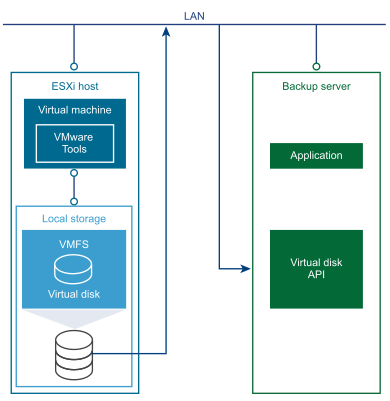When no other transport is available, networked storage applications can use LAN transport for data access, with NBD (network block device) protocol, optionally with SSL encryption, called NBDSSL. NBD is a Linux-style kernel module that treats storage on a remote host as a block device. NBDSSL is a VMware variant that uses SSL to encrypt all data passed over the TCP connection. The NBDSSL transport method is built into the virtual disk library, so it is always available, and is the fall-back when no other transport method is available.
VMware libraries often fall back to NBDSSL when other transports are not available. Backup applications can select NBD for higher throughput.

In this mode, the ESXi host reads data from storage and sends it across a network to the backup server. With LAN transport, large virtual disks can take a long time to transmit. This transport mode adds traffic to the LAN, unlike SAN and HotAdd transport, but NBDSSL transport offers the following advantages:
- The ESXi host can use any storage device, including local storage or remote-mounted NAS.
- The backup proxy can be a virtual machine, so customers can use vSphere resource pools to minimize the performance impact of backup. For example, the backup proxy can be in a lower-priority resource pool than the production ESXi hosts.
When VDDK opens a non-snapshot disk for NBDSSL transfer (read-only or read/write) it selects the ESXi host where the disk’s virtual machine currently resides.
However when VDDK opens a snapshot for NBDSSL transfer, the common backup case, VDDK passes the datastore to vCenter Server, which consults its list of ESXi hosts with access to the datastore; vCenter picks the first host with read/write access. The list of hosts is unordered, so the host chosen for NBDSSL transfer of the snapshot is not necessarily the ESXi host where the snapshot’s virtual machine resides.
NBDSSL Performance
When reading disk data using NBDSSL transport, VDDK makes synchronous calls. That is, VDDK requests a block of data and waits for a response. The block is read from disk and copied into a buffer on the server side, then sent over the network. Meanwhile, no data gets copied over the network, adding to wait time. To some extent, you can overcome this limitation by using multiple streams to simultaneously read from a single disk or multiple disks, taking advantage of parallelism.
As of vSphere 6.5, NBDSSL performance can be significantly improved using data compression. Three types are available – zlib, fastlz, and skipz – specified as flags when opening virtual disks with the extended VixDiskLib_Open() call. See Open a Local or Remote Disk.